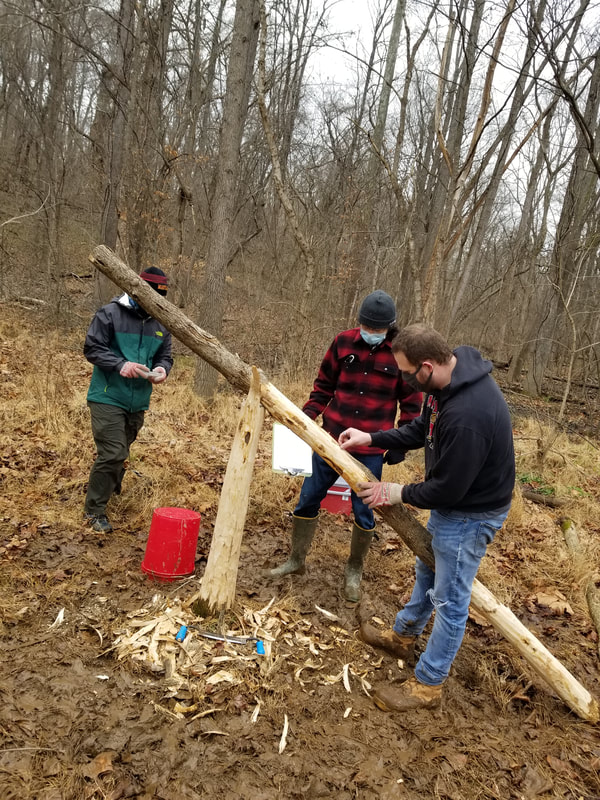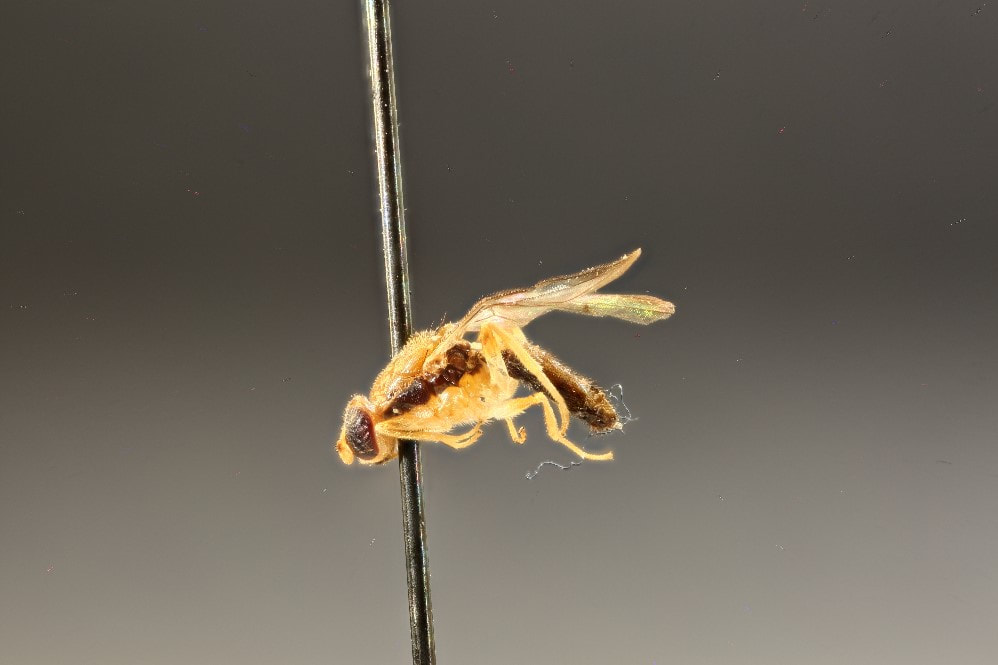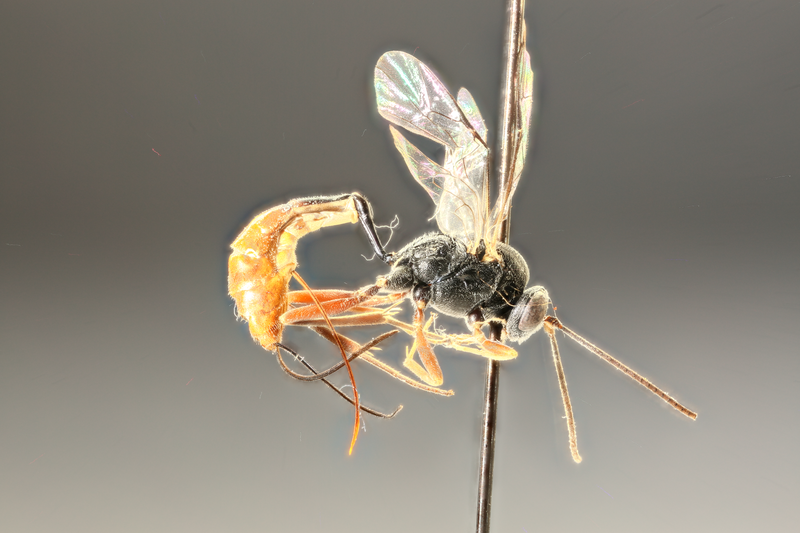Emerald Ash Borer
|
The emerald ash borer (Agrilus planipennis) commonly called EAB, is an invasive wood-boring beetle from eastern mainland Asia that attacks native ash species in the genus Fraxinus (Oleaceae). First detected near Detroit, Michigan in 2002, EAB has spread to at least 36 US states and 5 Canadian provinces. We aim to assess the ecological impact that the accidental introduction of this pest has caused these communities, as despite years of research, little is known on the subject.
We are investigating the impact of EAB on ash arthropod communities and assessing the efficacy of four parasitic wasps (Hymenoptera) released as classical biological control in Maryland and nationwide. These wasps pose no risk to humans as they lay their eggs inside the larvae or eggs of this beetle and may be an effective way to control the pest in both managed and natural forestry landscapes. For more information on EAB in Maryland, check out these extension resources. This page was compiled by Will Sargent. |
Log Collection and Rearing
We harvest logs of infested ash trees during the fall and winter to rear the emerald ash borer that lay dormant inside. The trees that are collected are still alive, but show many signs of heavy EAB infestation. These signs include crown dieback with epicormic shoots, copious woodpecker damage, and beetle exit holes. The emerged adults of EAB are used to culture colonies that support the research on this insect by the USDA Agricultural Research Service.
|
Rearing EAB requires a simulation of their natural growing environment. The EAB starts its life as an egg laid on a live ash tree. Once hatched, it bores into the bark’s into the cambium beneath the bark, where it feeds as it goes through larval stages, to pupae, to adults in the next 1-2 years.
Infested trees are collected, labeled, and cut into 2 ft sections before being stored in a walk-in refrigerator that keeps the insects dormant throughout the year. Over time these sections are rotated into our greenhouse barrel setup. Each barrel may contain up to 10 smaller branches or just one large log. The barrels are placed into a large greenhouse room in rows, labeled with the setup date, collection date, ID, and a barrel number. |

Each barrel has a sealed, modified lid with the identification information and two holes. A clear plastic cup guards these openings, and insects emerge and move to the light source where they are collected and processed.
The rearing barrels remain active for approximately two months to ensure all specimens are collected from the log. After this period, the logs are donated to homeowners with wood-burning stoves and the barrels are cleaned of any debris. Unfortunately, this high-quality hardwood, once infested with EAB, cannot be used for baseball bats, furniture, and other applications for which ash is famous.
The rearing barrels remain active for approximately two months to ensure all specimens are collected from the log. After this period, the logs are donated to homeowners with wood-burning stoves and the barrels are cleaned of any debris. Unfortunately, this high-quality hardwood, once infested with EAB, cannot be used for baseball bats, furniture, and other applications for which ash is famous.
Debarking
In addition to log collection and rearing, we also track EAB and other arthropods through annual debarking at select sites.
The debarking process involves carefully peeling back the bark of infested ash trees using draw knives. If done with enough caution, any insects living beneath the bark within the cambium can be observed and collected. Thanks to the EAB’s trademark galleries within the wood, we can follow its trail and record whether it survived, was eaten, or parasitized. When live larvae are found, they are collected and incubated in a growth chamber in order to rear, count, and identify parasitoids that attacked beetles in the field.
Combined with log rearing, debarking helps us to better understand the spread of EAB and its biological control. The debarking sites are specifically chosen with parasitoid release sites in mind, as well as areas with ample ash tree populations.
We would like to acknowledge the support of the University of Maryland Arboretum & Botanical Gardens in our research. In particular, we are grateful for the excellent training provided by Richard Jones, BCMA, University of Maryland Campus Arborist.
The debarking process involves carefully peeling back the bark of infested ash trees using draw knives. If done with enough caution, any insects living beneath the bark within the cambium can be observed and collected. Thanks to the EAB’s trademark galleries within the wood, we can follow its trail and record whether it survived, was eaten, or parasitized. When live larvae are found, they are collected and incubated in a growth chamber in order to rear, count, and identify parasitoids that attacked beetles in the field.
Combined with log rearing, debarking helps us to better understand the spread of EAB and its biological control. The debarking sites are specifically chosen with parasitoid release sites in mind, as well as areas with ample ash tree populations.
We would like to acknowledge the support of the University of Maryland Arboretum & Botanical Gardens in our research. In particular, we are grateful for the excellent training provided by Richard Jones, BCMA, University of Maryland Campus Arborist.
Frequently Asked Questions
What is the impact of your research?
Our research is used to inform the national community on control measures for emerald ash borer. Our assessment on the efficacy and impact of biological controls in Maryland can be used to inform public and academic authorities on the best practices for controlling the pest in states that emerald ash borer has not yet invaded.
In addition, our assessment of the pest’s ecological impacts and use of modeling to predict future ecological impacts will be vital in understanding how well ash forests can recover from invasion. This can inform us on best practices to aid in the recovery and regeneration of ash forests in similar environments across the nation.
Why do you need trees that are infested with emerald ash borer?
Emerald ash borer larvae feed on phloem tissue just under the bark of trees. Here they will wait out the cold winter and pupate to become adults in the spring. We harvest infested ash trees to collect these larvae while they are laying dormant for the winter. Once collected we will rear the adult beetles from the logs by incubating them for a period of about three weeks. Once the beetles have emerged we send them off to USDA:BIIRU in Newark, DE so their offspring can be used to rear parasitic wasps. These wasps are then released as part of field experiments used to assess several aspects of the wasp’s ecology, phenology, life cycle, and efficacy as a biological control.
Won't I be able to treat my trees with pesticides, why bother with biological control?
Chemical controls like TREEage (emamectin benzoate) work well to protect individual trees but are logistically ineffective at treating emerald ash borer on a large scale in more remote areas. A combination of biological control and chemical control aims to protect valuable trees with pesticides while controlling the pest at large in less managed landscapes. Chemical control is perfect for short term protection but is not reasonable for long-term control of the pest.
How can I learn more about emerald ash borer and keep up to date with recent information on the pest?
You can learn more about the emerald ash borer invasion and signs on how to spot it by visiting the UMD extension page on emerald ash borer by clicking here. You may also consider subscribing to Landscape and Nursery IPM Alerts located here to learn more information about other pests in our area.
I have a tree that's infested with emerald ash borer, would it be of any use to you?
We are always eager to find more locations to harvest logs for emerald ash borer rearing. While there is not guarantee that we would be able to collect or use your infested tree, it could certainly help us to be made aware of it. You can send us an email at [email protected]. Please include photos of the tree and your location.
What other insects are found in the rearing barrels, and are they beneficial?
There is a whole host of other insects that come out of the ash logs we collect, and we call these "associates" due to their association with ash trees. These insects range from parasitoid wasps that prey on a variety of larva, to flies, moths, and other native wood boring beetles. These insects are collected in ethanol and logged for further community analysis, so every insect counts! Below is a small gallery of the most common associates reared. Click on an associate to learn more about it.
Our research is used to inform the national community on control measures for emerald ash borer. Our assessment on the efficacy and impact of biological controls in Maryland can be used to inform public and academic authorities on the best practices for controlling the pest in states that emerald ash borer has not yet invaded.
In addition, our assessment of the pest’s ecological impacts and use of modeling to predict future ecological impacts will be vital in understanding how well ash forests can recover from invasion. This can inform us on best practices to aid in the recovery and regeneration of ash forests in similar environments across the nation.
Why do you need trees that are infested with emerald ash borer?
Emerald ash borer larvae feed on phloem tissue just under the bark of trees. Here they will wait out the cold winter and pupate to become adults in the spring. We harvest infested ash trees to collect these larvae while they are laying dormant for the winter. Once collected we will rear the adult beetles from the logs by incubating them for a period of about three weeks. Once the beetles have emerged we send them off to USDA:BIIRU in Newark, DE so their offspring can be used to rear parasitic wasps. These wasps are then released as part of field experiments used to assess several aspects of the wasp’s ecology, phenology, life cycle, and efficacy as a biological control.
Won't I be able to treat my trees with pesticides, why bother with biological control?
Chemical controls like TREEage (emamectin benzoate) work well to protect individual trees but are logistically ineffective at treating emerald ash borer on a large scale in more remote areas. A combination of biological control and chemical control aims to protect valuable trees with pesticides while controlling the pest at large in less managed landscapes. Chemical control is perfect for short term protection but is not reasonable for long-term control of the pest.
How can I learn more about emerald ash borer and keep up to date with recent information on the pest?
You can learn more about the emerald ash borer invasion and signs on how to spot it by visiting the UMD extension page on emerald ash borer by clicking here. You may also consider subscribing to Landscape and Nursery IPM Alerts located here to learn more information about other pests in our area.
I have a tree that's infested with emerald ash borer, would it be of any use to you?
We are always eager to find more locations to harvest logs for emerald ash borer rearing. While there is not guarantee that we would be able to collect or use your infested tree, it could certainly help us to be made aware of it. You can send us an email at [email protected]. Please include photos of the tree and your location.
What other insects are found in the rearing barrels, and are they beneficial?
There is a whole host of other insects that come out of the ash logs we collect, and we call these "associates" due to their association with ash trees. These insects range from parasitoid wasps that prey on a variety of larva, to flies, moths, and other native wood boring beetles. These insects are collected in ethanol and logged for further community analysis, so every insect counts! Below is a small gallery of the most common associates reared. Click on an associate to learn more about it.












